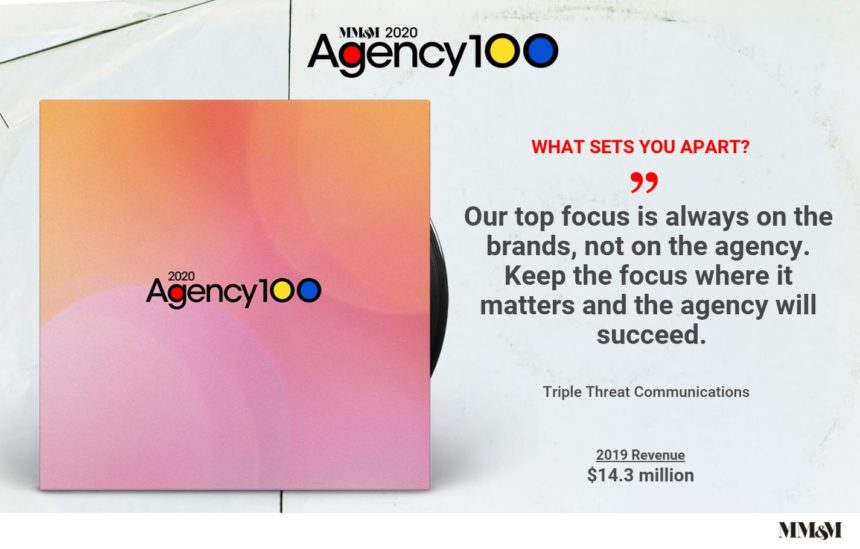Amid the COVID-19 crisis, many agencies have felt a financial pinch. But that hasn’t stopped Triple Threat Communications from offering its people a serious slate of perks — at least not yet, anyway.
“We obviously need to make a profit to stay in business, but we’re not trying to chase the dollar,” says managing partner Tim Frank. “We don’t focus on maximizing profit — that one word changes everything. Trust and transparency are big here.”
To that point, Frank reports that Triple Threat pays for 100% of its staffers’ health insurance and offers abundant paid vacation. It employs a mix of full-timers and freelance contributors.
Frank believes the firm’s approach engenders loyalty from employees — and, he says, clients as well. “They know we have their best interests at heart,” he explains. “Our staff is made up of experienced people who’ve gone through the big agency rigmarole for a decade or more and just want to get back to working on brands. We don’t set revenue targets for our teams, so their focus is always on what’s best for the brands.”
Head count stood at 49 at the end of 2019, up from 45 at the end of 2018, and Frank claims that fewer than a dozen people left the agency over the past decade. Last year’s key addition was EVP, global chief creative officer Adam Cohen, formerly managing partner/executive creative director at Concentric Health Experience.
Triple Threat saw revenue rise nearly 12% in 2019 to $14.3 million from $12.8 million in 2018. Client roster mainstays include AstraZeneca, Sobi and Innocoll Pharmaceuticals.

The agency was not, to Frank’s regret, able to expand its DTC capabilities during 2019. “It didn’t happen,” he concedes. “It was a goal, but it started to divert us and I’m not interested in creating a different capability just to generate revenue. If we can’t do the DTC thing really well, we won’t do it.”
As for how Triple Threat has adapted its business amid the coronavirus pandemic, Frank expresses relief that the company has long since subscribed to a remote working model. “We’re lucky we built the model that we did over the past decade,” he notes. “We’ve gotten better at it over time and the technology is so much better. We had to adjust client interactions, sure, but the way we do our work is no different than last year.”
Still, Frank doesn’t believe things will ever go back to the way they were. “Sales folks are building relationships with doctors in new ways and telemedicine will probably continue to flourish,” he continues. “But none of it will totally replace personal interaction. People still need to get together and build relationships.”
Frank speculates that large network agencies have been more disrupted by COVID-19 than organizations like Triple Threat. “We can get talent from anywhere; people don’t have to live nearby. If other agencies get better at it we might lose some of our competitive edge,” he says. But as a veteran of big-agency life himself, he only expects these companies to be able to change so much: “They’ll just go back to exactly what they know.”
The best marketing we saw in 2019…
GSK’s Breath of Life campaign did a great job of understanding core patient insights and integrating technology and creativity. Many COPD sufferers in China go undiagnosed, and the campaign encourages early checkups through a mobile phone app for self-testing. — Tim Frank
From the June 01, 2020 Issue of MM+M - Medical Marketing and Media







